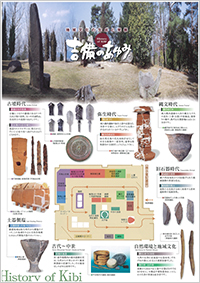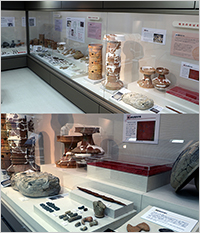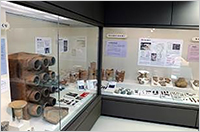Enlarge Image Exhibition of the Kofun Period ceramic coffins made by baking clay.
Enlarge Image Replica of Kotaiseki (carved stone).
Enlarge Image Clay Coffin.
Enlarge Image
 Okayama Travelogue
Okayama Travelogue
Okayama University Archaeological Museum
The Museum houses rare historically significant specimens such as pottery and metal ornaments from prehistoric Japan in the Palaeolithic, Jomon, Yayoi, and Kofun periods.
The Okayama University Archaeological Collections
The University Collections are broadly speaking the fruits of the research of two members of faculty at Okayama University. In 1965 the Faculty of Letters’ Department of Archaeology was founded with the vision of excavating sites within and around Okayama prefecture, and to further knowledge of prehistory and protohistory within the Japanese Archipelago. The University’s Archaeological Research Center is excavating sites unveiled within the campus, unearthed in the process of constructing and expanding facilities at Okayama University, such as the Tsushima-Okadai and the Shikata sites.
Photographs of wide range of exhibits on display in the museum
The exhibits are shown in chronological order with relics of the Stone Age excavated from the remains of the Onbara sites to those of the Heian period excavated from the vicinity of Shikata sites (Shikata campus.)
Specific exhibits at the museum
Replica of Kotaiseki (carved stone). This is a replica of the carved stone called Kotaiseki which was preserved on Tatetsuki tumuli of chiefs (Kurashiki city, Okayama prefecture) since the late Yayoi period (the second century A.D.). It is covered with winding parallel lines and circlar nodes. This pattern is also found in the ceremonial pottery related to the chieftainship in the Kibi region and inherited as a magical figure into the Kofun period with some transformation.
Clay Coffin.
This is a clay coffin from Yoshihara three tumulus (Sanyo town, Okayama Prefecture) from the beginning of the seventh century A.D. Such a clay coffin is a mortuary item that characterizes some parts of the Kinai and Kibi regions.





